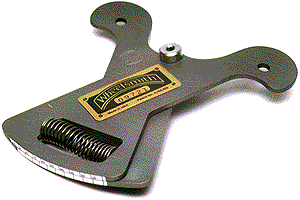I bought a Wheelsmith Tensiometer recently. The thing is specially designed so that a section of the spoke will snuggle into a little notch in each of its
ears. The previous poster was correct in that there's a spring in the middle, as you can see. On the bottom edge of each plate is a scale, they look something like this:
...TOP PLATE:.....|100..|90...|80...|70...|60...|50...|40...|30...|20...|10...|
BOTTOM PLATE:.....|.....|.....|.....|.....|.....|.....|.....|.....|.....|.....|
Once you've got the tool on the spoke you want to measure, you look at the scale and find the two lines that most closely line up. If the line is at 60, that's the reading. If two lines fall between 60 and 70, it's 65. Then you take a look at your calibration chart, and according to the thickness of the spoke (at center), it will give you the tension in kilograms—it lists round spoke thicknesses of 2.0, 1.8, 1.7, 1.6, 1.55, & 1.5 and aero spoke thicknesses of 1.4 x 2.6, 1.1 x 3.2, 1.2 x 2.2, & 0.9 x 3.1.
Apparently, each tensiometer is calibrated individually and so you can only use the chart that came w/ it. Another one won't give you an accurate reading. Both the tensiometer and the chart have a specific serial #.
As to building one at home, well... I guess you could give it a shot.

S.